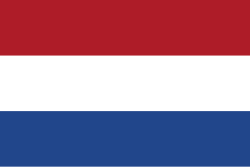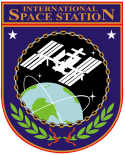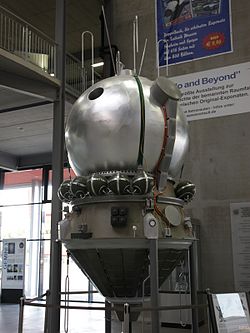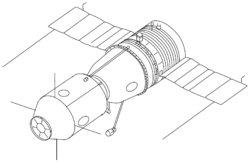Sojuz TMA-03M
| Sojuz TMA-03M (Союз ТMA-03M) | |||
| Beställare | Roskosmos | ||
|---|---|---|---|
| Modell | Sojuz-TMA-M | ||
| Tillverkare | RKK Energia | ||
| Operatör | Roskosmos | ||
| Färdens tid | 192 dagar, 18 tim, 58 min, 27 sek | ||
| NSSDC-ID | 2011-078A[1] | ||
| Uppskjutning | |||
| Startplats | Bajkonur 1/5 | ||
| Start | 21 december 2011, 13:16 UTC | ||
| Raket | Sojuz-FG | ||
| Landning | |||
| Landningsplats | 150 km SÖ om Zjezqazghan | ||
| Landning | 1 juli 2012, 08:14 UTC | ||
| Omloppsbana | |||
| Varv | 3 006 st[2] | ||
| Apogeum | 267 km | ||
| Perigeum | 199 km | ||
| Banlutning | 51.6° | ||
| Besättning | |||
| Besättning | Oleg Kononenko (2) André Kuipers (2) Donald Pettit (3) | ||
 Från vänster: Pettit, Kononenko, Kuipers | |||
| Dockning | |||
| Rymdstation | ISS | ||
| Dockning | 23 december 2011, 15:19:14 UTC | ||
| Port | Rassvet, nadir | ||
| Ur dockning | 1 juli 2012, 04:47:43 UTC | ||
| Tid dockad | 190 dagar, 13 tim, 28 min | ||
| Kronologi | |||
| |||
Sojuz TMA-03M (ryska: Союз ТMA-03M) var en flygning i det ryska rymdprogrammet. Flygningen transporterade Oleg Kononenko, André Kuipers och Donald Pettit till Internationella rymdstationen.
Farkosten sköts upp från Kosmodromen i Bajkonur, med en Sojuz-FG-raket, den 21 december 2011. Man dockade med rymdstationen den 21 december 2011.
Efter nästan 190 dagar lämnade farkosten rymdstationen den 1 juli 2012. Några timmar senare återinträdde den i jordens atmosfär och landade i Kazakstan.
I och med att farkosten lämnade rymdstationen var Expedition 31 avslutad.
Referenser
- Den här artikeln är helt eller delvis baserad på material från engelskspråkiga Wikipedia, Soyuz TMA-03M, 23 december 2011.
Noter
- ^ ”NASA Space Science Data Coordinated Archive” (på engelska). NASA. https://nssdc.gsfc.nasa.gov/nmc/spacecraft/display.action?id=2011-078A. Läst 29 februari 2020.
- ^ Manned Astronautics - Figures & Facts Arkiverad 5 oktober 2015 hämtat från the Wayback Machine., läst 10 oktober 2016.
| |||||||||||||||||||||||||||||||||||||||||||||||||||||||||||||||||||||||||||||||||||||||||
| |||||||||||||||||||||||||||||||
| ||||||||||||||||||||||||||||||||
Media som används på denna webbplats
Soyuz-TM spacecraft. Compare the antennas on the orbital module to those on Soyuz-T. Differences reflect the change from the Igla rendezvous system used on Soyuz-T to the Kurs rendezvous system used on Soyuz-TM.
In this illustration, a SpaceX Crew Dragon spacecraft approaches the International Space Station for docking. NASA is partnering with Boeing and SpaceX to build a new generation of human-rated spacecraft capable of taking astronauts to the station and expanding research opportunities in orbit. SpaceX's upcoming Demo-1 flight test is part of NASA’s Commercial Crew Transportation Capability contract with the goal of returning human spaceflight launch capabilities to the United States.
Apollo-Soyuz Test Project (ASTP) Soyuz. The APAS-75 docking unit is located at left.
The Soyuz TMA-04M spacecraft is seen after being rolled out by train to the launch pad at the Baikonur Cosmodrome in Kazakhstan, May 13, 2012. The launch of the Soyuz spacecraft, with Expedition 31 Soyuz Commander Gennady Padalka, Flight Engineer Sergei Revin of Russia and NASA Flight Engineer Joe Acaba, is scheduled for 9:01 a.m., May 15 (Kazakhstan time).
Författare/Upphovsman: Pascal (Flickr user: pasukaru76), Licens: CC0
Vostok spacecraft replica at the Technik Museum Speyer, Germany.
Backdropped by a blue and white Earth, this close-up view features the Soyuz TMA-6 spacecraft approaching the International Space Station (ISS). Onboard the spacecraft are cosmonaut Sergei K. Krikalev, Expedition 11 commander representing Russia's Federal Space Agency; astronaut John L. Phillips, NASA ISS science officer and flight engineer; and European Space Agency (ESA) astronaut Roberto Vittori of Italy. The Soyuz linked to the Pirs Docking Compartment at 9:20 p.m. (CDT) on April 16, 2005 as the two spacecraft flew over eastern Asia. The docking followed Friday’s launch from the Baikonur Cosmodrome in Kazakhstan.
Russian cosmonaut Oleg Kononenko (center), Expedition 30 flight engineer and Expedition 31 commander; NASA astronaut Don Pettit (left) and European Space Agency astronaut Andre Kuipers, both Expedition 30/31 flight engineers, pose for a portrait following an Expedition 30/31 preflight press conference at NASA's Johnson Space Center.
Rotated and color enhanced version of original (ISS013-E-48788 (6 July 2006) --- The Space Shuttle Discovery approaches the International Space Station for docking but before the link-up occurred, the orbiter went through a series of inspection photos by station crew to inspect the vehicle for any damage to its Thermal Protection System. This was known as the Rendezvous Pitch Maneuver and was implemented after the Columbia Disaster in 2003. The Leonardo Multipurpose Logistics Module can be seen in the shuttle's cargo bay. Discovery docked at the station's Pressurized Mating Adapter 2 at 9:52 a.m. CDT, July 6, 2006.)
Soyuz-A manned spacecraft concept (1963). It was to have been part of the Soyuz A-B-C circumlunar complex.



















